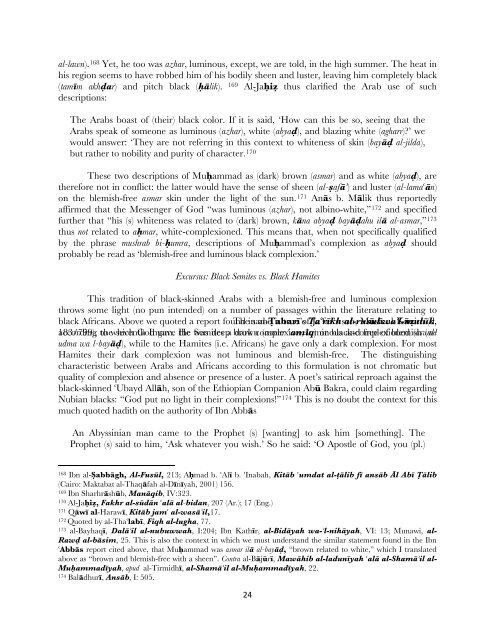“Anyone who says that the Prophet is black should be killed”: The ...
“Anyone who says that the Prophet is black should be killed”: The ...
“Anyone who says that the Prophet is black should be killed”: The ...
You also want an ePaper? Increase the reach of your titles
YUMPU automatically turns print PDFs into web optimized ePapers that Google loves.
al-lawn). 168 Yet, he too was azhar, luminous, except, we are told, in <strong>the</strong> high summer. <strong>The</strong> heat in<br />
h<strong>is</strong> region seems to have rob<strong>be</strong>d him of h<strong>is</strong> bodily sheen and luster, leaving him completely <strong>black</strong><br />
(tamÊm akh∙ar) and pitch <strong>black</strong> (ȧlik). 169 Al-JaÈií thus clarified <strong>the</strong> Arab use of such<br />
descriptions:<br />
<strong>The</strong> Arabs boast of (<strong>the</strong>ir) <strong>black</strong> color. If it <strong>is</strong> said, ‘How can th<strong>is</strong> <strong>be</strong> so, seeing <strong>that</strong> <strong>the</strong><br />
Arabs speak of someone as luminous (azhar), white (abya∙), and blazing white (agharr)?’ we<br />
would answer: ‘<strong>The</strong>y are not referring in th<strong>is</strong> context to whiteness of skin (bay§∙ al-jilda),<br />
but ra<strong>the</strong>r to nobility and purity of character. 170<br />
<strong>The</strong>se two descriptions of MuÈammad as (dark) brown (asmar) and as white (abya∙), are<br />
<strong>the</strong>refore not in conflict: <strong>the</strong> latter would have <strong>the</strong> sense of sheen (al-ßaf§") and luster (al-lama#§n)<br />
on <strong>the</strong> blem<strong>is</strong>h-free asmar skin under <strong>the</strong> light of <strong>the</strong> sun. 171 An§s b. M§lik thus reportedly<br />
affirmed <strong>that</strong> <strong>the</strong> Messenger of God “was luminous (azhar), not albino-white,” 172 and specified<br />
fur<strong>the</strong>r <strong>that</strong> “h<strong>is</strong> (s) whiteness was related to (dark) brown, k§na abya∙ bay§∙ahu il§ al-asmar,” 173<br />
thus not related to aÈmar, white-complexioned. Th<strong>is</strong> means <strong>that</strong>, when not specifically qualified<br />
by <strong>the</strong> phrase mushrab bi-Èumra, descriptions of MuÈammad’s complexion as abya∙ <strong>should</strong><br />
probably <strong>be</strong> read as ‘blem<strong>is</strong>h-free and luminous <strong>black</strong> complexion.’<br />
Excursus: Black Semites vs. Black Hamites<br />
Th<strong>is</strong> tradition of <strong>black</strong>-skinned Arabs with a blem<strong>is</strong>h-free and luminous complexion<br />
throws some light (no pun intended) on a num<strong>be</strong>r of passages within <strong>the</strong> literature relating to<br />
<strong>black</strong> Africans. Above we quoted a report found <strong>The</strong> in same al-•abarÊ’s <strong>is</strong> true of Ta"rÊkh Ja#far’s son, al-rusul Mås§ wa"l-mulåk,<br />
al-K§íim (d.<br />
183/799), according to <strong>the</strong> which seventh God Imam. gave He <strong>the</strong> was Semites deep a brown dark complexion, (asmar #amÊq) luminous or <strong>black</strong>-complexioned and free of blem<strong>is</strong>h (aswad (aludma<br />
wa l-bay§∙), while to <strong>the</strong> Hamites (i.e. Africans) he gave only a dark complexion. For most<br />
Hamites <strong>the</strong>ir dark complexion was not luminous and blem<strong>is</strong>h-free. <strong>The</strong> d<strong>is</strong>tingu<strong>is</strong>hing<br />
character<strong>is</strong>tic <strong>be</strong>tween Arabs and Africans according to th<strong>is</strong> formulation <strong>is</strong> not chromatic but<br />
quality of complexion and absence or presence of a luster. A poet’s satirical reproach against <strong>the</strong><br />
<strong>black</strong>-skinned #Ubayd All§h, son of <strong>the</strong> Ethiopian Companion Abå Bakra, could claim regarding<br />
Nubian <strong>black</strong>s: “God put no light in <strong>the</strong>ir complexions!” 174 Th<strong>is</strong> <strong>is</strong> no doubt <strong>the</strong> context for th<strong>is</strong><br />
much quoted hadith on <strong>the</strong> authority of Ibn Abb§s<br />
An Abyssinian man came to <strong>the</strong> <strong>Prophet</strong> (s) [wanting] to ask him [something]. <strong>The</strong><br />
<strong>Prophet</strong> (s) said to him, ‘Ask whatever you w<strong>is</strong>h.’ So he said: ‘O Apostle of God, you (pl.)<br />
168 Ibn al-‘abb§gh, Al-Fusål, 213; AÈmad b. #AlÊ b. #Inabah, Kit§b #umdat al-ã§lib fÊ ans§b $l AbÊ •§lib<br />
(Cairo: Maktabat al-Thaq§fah al-DÊnÊyah, 2001) 156.<br />
169 Ibn Sharhr§shåb, Man§qib, IV:323.<br />
170 Al-JaÈií, Fakhr al-såd§n #al§ al-bidan, 207 (Ar.); 17 (Eng.)<br />
171 Q§wÊ al-HarawÊ, Kit§b jam# al-was§"il,17.<br />
172 Quoted by al-Tha#labÊ, Fiqh al-lugha, 77.<br />
173 al-BayhaqÊ, Dal§"il al-nubuwwah, I:204; Ibn KathÊr, al-Bid§yah wa-"l-nih§yah, VI: 13; Munawi, al-<br />
Raw∙ al-b§sim, 25. Th<strong>is</strong> <strong>is</strong> also <strong>the</strong> context in which we must understand <strong>the</strong> similar statement found in <strong>the</strong> Ibn<br />
#Abb§s report cited above, <strong>that</strong> MuÈammad was asmar il§ al-bay§∙, “brown related to white,” which I translated<br />
above as “brown and blem<strong>is</strong>h-free with a sheen”. Contra al-B§jårÊ, Maw§hib al-ladunÊyah #al§ al-Sham§"il al-<br />
MuÈammadÊyah, apud al-TirmidhÊ, al-Sham§"il al-MuÈammadÊyah, 22.<br />
174 Bal§dhurÊ, Ans§b, I: 505.<br />
24
















